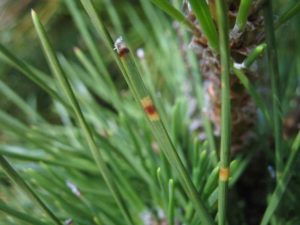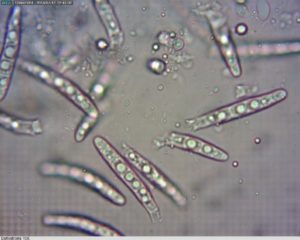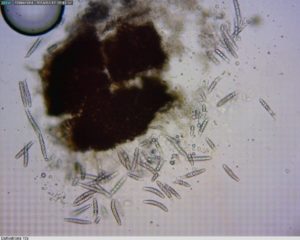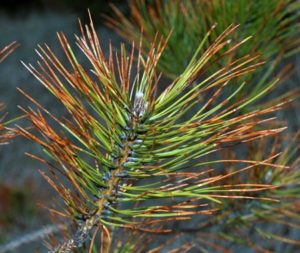Written by Christina Lanzoni – TPDDL Student Worker;
Edited by Hannah Ayala – Extension Assistant
‘Twas the day before Christmas and all through the night
Spores were dispersing causing Dothistroma needle blight
It’s that time of year again where everyone is out buying Christmas trees to decorate their homes. Without proper care, those trees would not be available for us to put gifts under.
One of the most common foliar diseases seen in pine trees is Dothistroma needle blight. It affects the needles of over 30 different species of pine trees. When the plant in first infected, brown spots with yellow bands form around the needles. As the infection continues the part of the needle above the band begins to die and turn brown. Symptoms will be the most prominent in the lower part of the tree. This is especially a problem for younger pines, because they are more susceptible to damage than older ones.
 Photo Credit: Missouri Botanical Garden – missouribotanicalgarden.org
Photo Credit: Missouri Botanical Garden – missouribotanicalgarden.org
Dothistroma needle blight is caused by the fungus Mycosphaerella pini (formerly Dothistroma septosporum). The spores of this fungus overwinter in infected needles. M. pini forms fruiting bodies called pycnidia on the needles of infected trees. These pycnidia appear as small black spots emerging from the surface of the needle. Spores are formed within these structures and are spread during periods of wet weather where they can infect other nearby pines. Infection can take place spring through autumn. Symptoms of the disease may appear anywhere from five weeks to six months after infection.


There are a few approaches to dealing with this disease. Dothistroma needle blight can be prevented by planting resistant pine varieties. Providing adequate spacing between trees can allow for good airflow that will help dry the needles and prevent the spread of the spores. If there are trees suffering from Dothistroma needle blight nearby, try to remove any fallen needles, which can serve as another source of spores. A fungicide with a copper base, like Bordeaux mixture, can also be applied to control its spread. Be sure to read and follow the instructions on the label before use.
So remember, rake your pine needles and properly space your trees. Simple tasks like these can help prevent the loss of our Christmas trees.
 Photo Credit: Jill O’Donnel, MSU Extension – canr.msu.edu
Photo Credit: Jill O’Donnel, MSU Extension – canr.msu.edu
References:
https://www.canr.msu.edu/news/managing_dothistroma_and_brown_needle_blight_on_pines
https://hort.uwex.edu/articles/dothistroma-needle-blight/
http://www.missouribotanicalgarden.org/gardens-gardening/your-garden/help-for-the-home-gardener/advice-tips-resources/pests-and-problems/diseases/needlecasts/dothistroma-blight.aspx



